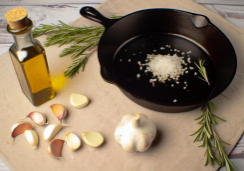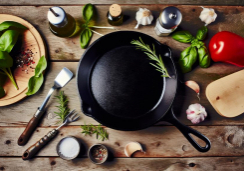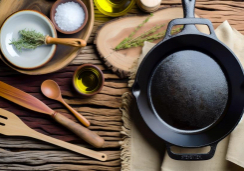Trustworthy Guide to Wholesome Stir-Fry Basics
As you stand at the crossroads of culinary exploration, eager to embark on the path of creating wholesome stir-fries, it's crucial to have a compass that points true north. You're in search of flavors that dance harmoniously together on your palate and nutrients that nourish your body, yet you may find yourself daunted by the vast sea of advice available.
Rest assured, you've anchored at the right harbor. This guide will serve as your steadfast companion through the essentials of stir-frying, ensuring you're well-equipped with the knowledge to select the freshest ingredients, wield your equipment with confidence, and master the dance of heat control.
It's about striking the perfect balance between vibrant vegetables and succulent proteins, all united by the symphony of spices and sauces. As we embark on this journey, you'll discover the secrets to a perfect stir-fry that's both delectable and nutritionally sound.
Yet, the true art lies not only in the steps but in the subtle techniques that elevate a simple dish to a masterpiece. Stay with me, and you'll soon unveil these culinary treasures that will transform your stir-fries from mere meals to memorable feasts.
Selecting Fresh Ingredients
To whip up a truly wholesome stir-fry, you'll want to start by handpicking the freshest ingredients, ensuring they're bursting with color, firm to the touch, and free from any imperfections. Your vegetables shouldn't only add a splash of color to your palette but also offer a crisp texture that enhances the dish. Seek out vibrant greens like bok choy, its leaves a deep emerald and stalks a glossy white, signaling its freshness.
You'll know the fruits and vegetables are at their peak if they're plump and devoid of bruises or soft spots. These blemishes can indicate underlying decay, which could compromise the flavor and nutritional value of your meal. Freshness extends to your choice of herbs as well; they should boast bright, crisp leaves, free from any brown edges or limpness.
When it comes to proteins, lean cuts of meat are your best bet for a balanced stir-fry. Select cuts that are fresh, with no off-putting odors or discoloration. If you can, opt for organic and locally sourced options. They often offer superior taste and contribute to a more nutrient-packed dish, making your stir-fry not just a meal, but a vibrant mosaic of garden-fresh goodness.
Preparing Your Equipment
Having the right tools at hand is crucial as you embark on your stir-fry adventure, starting with a stable, flat-bottomed wok perfectly designed for your stovetop's surface. This essential piece ensures even heat distribution, making your stir-frying experience smoother and more efficient.
But the prep doesn't end there. Here's what you need to do:
- Prep Your Wok
- *Seasoning Is Key*: Before the first use, season your wok to create a non-stick surface and impart a depth of flavor that's unmatched.
- *Stability Matters*: A flat-bottomed wok will sit securely on your stovetop, ensuring that the heat is concentrated and your ingredients are cooked evenly.
- Gather Your Utensils
- *The Right Tool*: A long-handled wooden spoon or a wok spatula is your best friend for quick, agile stir-frying.
- *Alternative Options*: Don't have a wok? A high-quality non-stick frying pan can be a great substitute.
Mastering Heat Control
Mastering heat control is essential in stir-frying, as it allows you to sear and cook ingredients to perfection while preserving their distinct textures and flavors. When you heat your wok over medium-high heat, you create the ideal environment for a quick sear that locks in the juiciness of your proteins and the crispness of your veggies. As you toss and turn the ingredients, the high heat chars them slightly, imparting that coveted smoky flavor without overcooking.
Adjusting the heat is like conducting an orchestra; each ingredient enters at a tempo that suits its nature. Proteins that require a thorough sear demand the wok's initial blast of high heat, while quick-cooking vegetables join the melody without missing a beat. You'll lower the heat as you add your stir-fry sauce, allowing it to simmer and thicken without scorching.
Continue to cook, stirring constantly, to ensure even heat distribution. The dance of ingredients in the wok is a delicate balance—too hot, and they'll burn; too cold, and they'll stew in their juices. With practice, you'll develop an instinct for when to crank up the flame and when to let the dish mellow, achieving that perfect harmony of caramelization, tenderness, and crispness every time.
Stir-Fry Cooking Sequence
As you've honed your skills in heat control, let's explore how to sequence your stir-fry for that perfect blend of textures and flavors. The stir-fry cooking sequence is crucial to ensuring each ingredient is cooked just right, marrying flavors while maintaining a delightful crunch in your stir-fry vegetables.
Here's the breakdown:
- Prep Every Ingredient: Before heating up your wok, make sure everything is chopped, measured, and within arm's reach.
- Proteins: Cut into even, bite-sized pieces.
- Vegetables: Washed, trimmed, and sliced accordingly.
- Cook in Stages:
- Proteins first: Sear your chosen protein until it's golden and nearly cooked through, then remove it from the wok. This step is key to avoid overcooking when you add the protein back.
- Aromatics and Vegetables: Toss in garlic, ginger, or onions to release their fragrances, followed by the harder veggies. Once they're tender yet crisp, mix in any leafy greens.
Lastly, push your veggies to the sides, creating a well in the center. Pour your savory sauce into this 'donut' and let it bubble before folding everything together. Return the protein to the wok, give it a good toss, and serve up your vibrant, flavor-packed stir-fry.
What Are the Essential Basics for Healthy Stir-Frying?
When it comes to beginner’s healthy stirfrying, the essential basics include using a good quality non-stick pan or wok, choosing the right cooking oil like olive or coconut oil, and incorporating plenty of fresh vegetables and lean proteins. It’s also important to avoid overcooking the ingredients to retain their nutrients.
Flavoring With Spices and Sauces
When you're ready to elevate your stir-fry, a splash of soy sauce or a sprinkle of fresh herbs can transform simple ingredients into a culinary masterpiece. The secret to an aromatic and savory dish often lies in the sauce and Chinese cooking tradition offers a wealth of inspiration. The rich umami of soy sauce, the complex sweetness of oyster sauce, or the tangy zip of teriyaki sauce can each be the foundation of your stir-fry's flavor profile.
Don't hesitate to experiment with herbs and spices. Garlic adds a pungent punch, ginger brings a warming zing, and chili flakes kick up the heat. These sauce ingredients work together to customize your dish to the exact taste you crave.
Consider the protein and vegetables as your canvas, with tofu, shrimp, or beef adding substance, and a variety of veggies contributing color and crunch. To achieve a perfectly balanced stir-fry, play with contrasts; a drizzle of honey or a dash of brown sugar can offset the salty depth of the sauces, ensuring every bite is a harmonious blend of flavors.
Conclusion
Now you've got the scoop on stir-frying success! With fresh ingredients lined up, your wok seasoned and sizzling, and those heat control skills honed, you're all set.
Remember, it's all about timing—get that sequence right, and let the spices and sauces work their magic. Embrace the sizzle, relish the aromas, and get ready to serve up a feast that's as nutritious as it's tasty.
You're not just cooking; you're creating culinary art. Stir-fry away!










